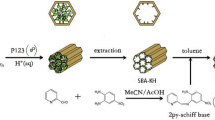Abstract
The metal cation sensing material was prepared by entrapment of a water-soluble porphyrin compound, meso-terakis(4-N,N,N-trimethylamiophenyl) porphyrin (TTMAPP), in mesoporous molecular sieve MCM-41. The powder X-ray diffraction (XRD) spectra results demonstrated that after the introduction of TTMAPP, the ordered channel arrangement of MCM-41 remained. The assembly material, TTMAPP/ MCM-41, exhibited a typical absorption feature of porphyrin compound. Emission spectrum study revealed that the introduction of zinc (II) cation resulted in the formation of a new emission peak at 600 nm for TTMAPP/MCM-41, while the presence of copper (II) cation at low concentration led to that the luminescent intensity of TTMAPP/MCM-41 was obviously reduced by 68.42%. The experiment results demonstrated that TTMAPP/MCM-41 is a cation sensing materials with good performance.
Similar content being viewed by others
References
Saban, S. B., Darling, R. B., Multi-element heavy metal ion sensors for aqueous solutions, Sensors and Actuators B, 1999, 61: 128–137.
Xia, W. S., Schmehl, R. H., Li, C. J. et al., Chemosensors for lead(II) and alkali metal ions based on self-assembling fluorescence enhancement (SAFE), J. Phys. Chem. B, 2002, 106: 833–843.
Chen, C. T., Huang, W. P., A highly selective fluorescent chemosensor for lead ions, J. Am. Chem. Soc., 2002, 124: 6247.
Torrado, A., Walkup, G. K., Imperiali. B., Exploiting polypeptide motifs for the design of selective Cu(II) ion chemosensors, J. Am. Chem. Soc., 1998, 120: 609–610.
Ji, H. F., Dabestani, R., Brown, G. M. et al., A new highly selective calix[4]crown-6 fluorescent caesium probe, Chem. Commun., 2000, 833-834.
Walkup, G. K., Imperiali, B., Stereoselective synthesis of fluorescent r-amino acids containing oxine (8-hydroxyquinoline) and their peptide incorporation in chemosensors for divalent zinc, J. Org. Chem., 1998, 63: 6727–6731.
Zeng, H. H., Thompson, R. B., Maliwal, B. P. et al., Real-time determination of picomolar free Cu(II) in seawater using a fluorescence-based fiber optic biosensor, Anal. Chem., 2003, 75: 6807–6812.
Torrado, A., Walkup, G. K., Imperiali, B., Exploiting polypeptide motifs for the design of selective Cu(II) ion chemosensors, J. Am. Chem. Soc., 1998, 120: 609–610.
Burdette, S. C., Walkup, G. K., Spingler, B. et al., Fluorescent sensors for Zn2+ based on a fluorescein platform: synthesis, properties and intracellular distribution, J. Am. Chem. Soc., 2001, 123: 7831–7841.
Winkler, J. D., Bowen, C. M., Michelet, V., Photodynamic fluorescent metal ion sensors with parts per billion sensitivity, J. Am. Chem. Soc., 1998, 120: 3237–3242.
Nolan, E. M., Burdette, S. C., Harvey, J. H. et al., Synthesis and characterization of zinc sensors based on a monosubstituted fluorescein platform, Inorganic Chemistry, 2004, 43: 2624–2635.
Burdette, S. C., Lippard, S. J., The rhodafluor family. An initial study of potential ratiometric fluorescent sensors for Zn2+, Inorganic Chemistry, 2002, 41: 6816–6823.
Aoki, S., Kaido, S., Fujioka, H. et al., A new zinc(II) fluorophore 2-(9-Anthrylmethylamino)ethyl-appended 1,4,7,10-Tetraazacyclododecane, Inorganic Chemistry, 2003, 42: 1023–1030.
Mehnert, C. P., Weaver, D. W., Ying, J. Y., Heterogeneous heck catalysis with palladium-grafted molecular sieves, J. Am. Chem. Soc., 1998, 120: 12289–12296.
Zhang, H. Y., He, Y J., Chen, Y. B., Structure and positron annihilation spectra of tin incorporated in mesoporous molecular sieves, Journal of Applied Physics, 2002, 92: 7636–7640.
Zhao, X. S., Lu, M. G. Q., Song, C., Immobilization of aluminum chloride on MCM-41 as a new catalyst system for liquid-phase isopropylation of naphthalene, Journal of Molecular A-chemical, 2003, 191:67–74.
Lei, J., Fan, J., Yu, C. Z., Immobilization of enzymes in mesoporous materials: controlling the entrance to nanospace, Microporous and Mesoporous Materials, 2004, 73: 121–128.
Chong, A. S. M., Zhao, X. S., Functionalized nanoporous silicas for the immobilization of penicillin acylase, Applied Surface Science, 2004, 237: 398–404.
Huo, Q. S., Feng, J. L., Schuth, Fi. et al., Preparation of hard mesoporous silica spheres, Chem. Mater., 1997, 9: 14–17.
Wirnsberger, G., Scott, B. J., Stucky, G D., PH sensing with mesoporous thin films, Chem. Commun., 2001, 119–120.
Zhang, P., Guo, J. H., Wang, Y. et al., Incorporation of luminescent tris(bipyridine)ruthenium(II) complex in mesoporous silica spheres and their spectroscopic and oxygen-sensing properties, Materials Letters, 2002, 53: 400–405.
Payra, P., Dutta, P. K., Development of a dissolved oxygen sensor using tris(bipyridyl) ruthenium (II) complexes entrapped in highly siliceous zeolites, Microporous and Mesoporous Materials, 2003, 64: 109–118.
Onida, B., Bonelli, B., Flora, L. et al., Permeability of micelles in surfactant-containing MCM-41 silica as monitored by embedded dye molecules, Chem. Commun., 2001, 2216–2217.
Author information
Authors and Affiliations
Corresponding author
About this article
Cite this article
Zhang, H., Sun, Y., Zhang, P. et al. Metal cation sensing material based on the assembly of meso-terakis(4-N,N,N-trimethylamiophenyl) porphyrin and mesoporous molecular sieve MCM-41. Chin.Sci.Bull. 50, 1699–1702 (2005). https://doi.org/10.1360/982004-818
Received:
Accepted:
Issue Date:
DOI: https://doi.org/10.1360/982004-818




